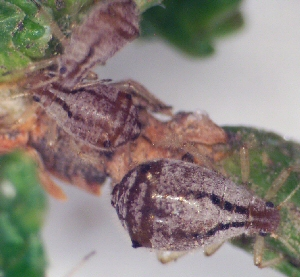Arborvitae Aphid
 Scientific Name
Scientific Name
Cinara tujafilina
Host
For all practical purposes, the only host in Oklahoma is arborvitae. This species has, however, been reported on Italian cypress, red cedar, and retinospora in other areas of the country.
Symptoms
This species has been reported to cause foliage to turn brown and to kill branches of arborvitae and Italian cypress. We seldom see serious damage in Oklahoma but it probably occurs in mild winters when heavy infestations are present for long periods. They may have considerable annoyance value as they produce large amounts of honeydew which can drip on cars, sidewalks, etc. and attracts flies, wasps, and other insects to infested plants. Also, this aphid sometimes leaves infested plants in March or April and can be found crawling on sidewalks, walls, or other trees or shrubs.
Life Cycle
This aphid can appear on arborvitae anytime between late October and early December (most commonly about the middle of November). They feed and reproduce whenever temperatures allow, probably producing several generations in mild winters. They can tolerate relatively cold weather, but at least part of the population will be killed if temperatures drop much below 10°F. Large numbers may be found as early as late January, but are more commonly found in March and April. Numbers usually begin to decrease in April and infestations disappear in May. Oversummering forms have not been found in Oklahoma; however, they probably occur on the roots of infested arborvitaes.
Description
This is a relatively large aphid with adults ranging up to 1/ 8 inch long. It is brownish in color and is partly covered with a whitish, waxy secretion. It has a broad body and long legs. The cornicles are broad, short, and cone-shaped. A second species of Cinara, C. idahoensis, is occasionally found on arborvitae in Oklahoma. It is similar to C. tujafilina in size and shape but is green in color. Other species of Cinara in the state are found on pines.
Control
Please contact your local county extension office for current information.


